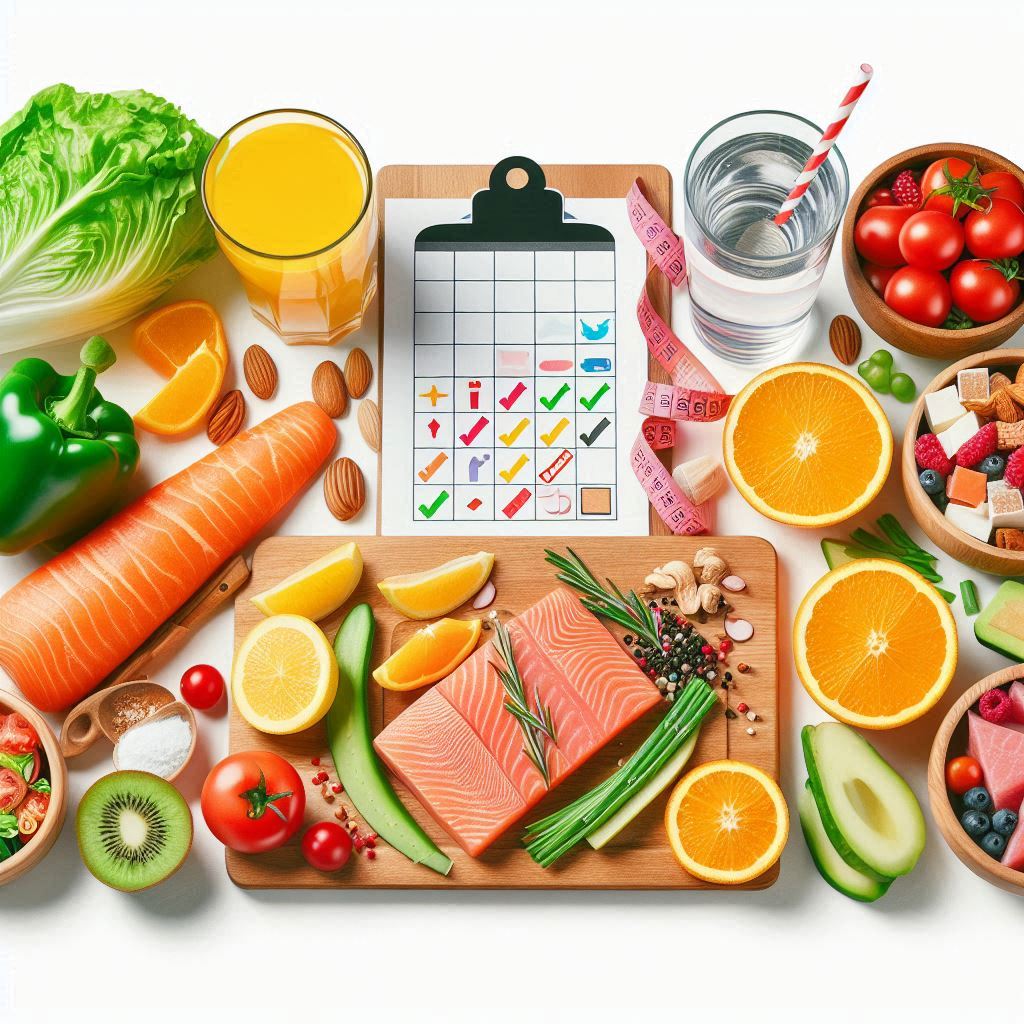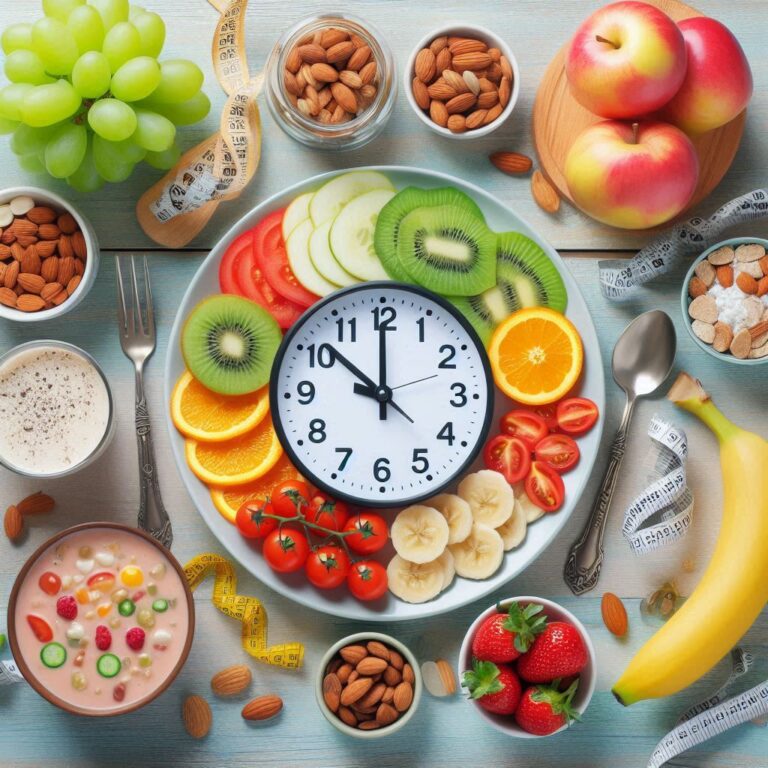Personalization is key to a successful weight-loss diet. Everyone’s body and lifestyle are different – age, gender, height, activity level, food preferences, and cultural background all affect what diet works best for you. A tailored meal plan meets your unique needs, making it easier and more enjoyable to stick to. For example, the American Heart Association recommends a healthy eating pattern “tailored to your personal and cultural food preferences,” with a variety of vegetables, fruits, whole grains, lean proteins and healthy fats(Source). By adjusting your plan to fit you – rather than following a one-size-fits-all diet – you’re more likely to get the right nutrients and maintain weight loss long-term.
Step 1: Calculate Your Calorie Needs
First determine how many calories you need each day to maintain your current weight. You can use an online calculator or a formula like the Mifflin–St. Jeor equation to estimate your Basal Metabolic Rate (BMR) – the calories your body burns at rest. For example, Medscape notes that Mifflin–St. Jeor is “a widely used tool to determine the resting metabolic rate” (RMR) for healthy adults(Source). The formula (in metric units) is:
- Women:
BMR = 10×weight(kg) + 6.25×height(cm) – 5×age – 161 - Men:
BMR = 10×weight(kg) + 6.25×height(cm) – 5×age + 5
Then multiply your BMR by an activity factor (e.g. 1.2 for sedentary, up to ~1.9 for very active) to get your Total Daily Energy Expenditure (TDEE). This TDEE is roughly the calories to maintain your weight. (If you prefer, simple rules of thumb exist – e.g. some experts say a moderately active person needs ~15 calories per pound of body weight to maintain(Source) – but the formula is more precise.)
Use this maintenance number as your baseline. For weight loss, you’ll eat less than your TDEE. A common target is a 500–1,000 calorie deficit per day, which typically leads to losing about 1–2 pounds per week(Source). (Health authorities agree that 1–2 lbs/week is a realistic, safe rate(Source)(Source).) Avoid cutting calories too drastically; Harvard experts warn that dropping below about 1,200 calories daily (for most women) or 1,500 for men can “endanger your health by depriving you of needed nutrients”(Source). Instead, aim for a moderate deficit – for example, if your maintenance is 2,200 calories, a goal of 1,700–1,800 per day would typically yield ~1 lb lost per week.
Step 2: Set Realistic Weight-Loss Goals
Choose a goal weight or loss rate that is steady and sustainable. Health experts recommend aiming for 1–2 pounds of weight loss per week(Source). This means reducing about 500–1,000 calories per day below maintenance, through a mix of eating less and moving more. Losing more than this can be very hard to sustain and may harm metabolism or muscle. For instance, a Harvard Health guide notes that extreme deficits (dropping calories too much) can backfire – you may become very hungry, lose muscle mass, and slow down your metabolism(Source).
To set your goal, first decide how much total weight to lose and over what time. For example, if you want to lose 15 pounds, at 1–2 per week that might take 8–12 weeks. Make sure to break this into short-term milestones (like 2–3 pounds per month) and celebrate each success. Remember: steady progress is better than “all-or-nothing.” By setting a moderate pace (like 1 lb/week) you allow room for lifestyle changes and avoid the disappointment that comes from aiming unrealistically high.
Step 3: Choose Your Macronutrient Balance
Decide on a healthy balance of protein, fat, and carbohydrates that works for you. The Dietary Guidelines recommend that adults generally get about 45–65% of calories from carbs, 20–35% from fat, and 10–35% from protein(Source)(Source). However, within these ranges you can adjust based on your needs and preferences. For weight loss, many people find it helpful to eat on the higher end of protein. Protein is very satisfying: it takes more energy to digest than carbs and helps you feel full longer(Source). Harvard experts note that diets higher in protein often reduce hunger and support weight loss. As a rough guide, getting 20–30% of calories from protein can help preserve muscle and curb cravings. Include healthy fats (avocado, nuts, olive oil) for satiety and nutrients. Pick mostly complex, fiber-rich carbs: vegetables, fruits, legumes and whole grains. For example, focus on whole-grain breads, oats, brown rice and sweet potatoes instead of refined grains and sugar. These foods provide steady energy and help you stay full (high-fiber foods “keep you fuller longer,” which aids weight control(Source)).
Above all, remember flexibility: there’s no single “perfect” macro ratio for everyone. The most important factor is a calorie deficit(Source), so choose a balance you enjoy and can maintain. For instance, if you like whole-grain pasta, include it in sensible portions; if you prefer a lower-carb style, fill up on extra vegetables and lean protein. Your plan should fit your tastes and habits – which makes it easier to stick to long term.
Step 4: Plan Nutrient-Dense, Controlled-Portion Meals
Build meals that are rich in nutrients but moderate in calories. Aim to fill half your plate with non-starchy vegetables and fruits, which are high in fiber and water (they take up space in your stomach so you feel full on fewer calories). As one guide points out, covering at least half your plate with colorful veggies “makes you feel full on fewer calories”(Source). The rest of your plate can be lean protein (chicken, fish, beans, tofu, eggs) and a smaller portion of whole grains or starchy vegetables. This helps control portions naturally: a standard lunch might be a salad (veggies + olive oil and vinegar dressing) with grilled chicken and a half cup of brown rice, plus fruit. A serving of lean protein (3–4 oz of meat or fish, or ½ cup of beans) combined with veggies and a serving of whole grains or starchy veggies (1 cup) generally fits a balanced meal.
To manage portion sizes at home, try simple tricks: use a smaller plate or bowl, measure portions (for example, a fist-sized portion of rice or pasta, a palm-sized portion of meat), or pre-portion snacks into small bags. Be mindful when eating out – restaurants often serve large portions. Nutrition labels can help: always check the serving size and number of servings per container(Source) so you know how much you’re really eating. Focus on nutrient density: choose foods high in fiber, protein, vitamins and minerals rather than empty calories. For example, swap white bread for whole-grain, and add beans or vegetables to pasta dishes to boost volume and nutrition. The American Heart Association emphasizes a wide variety of vegetables, whole grains, legumes, nuts, fish, and low-fat dairy as the foundation of a healthy pattern(Source).
Portion and Plate Tips: For easy portions, remember the “hand method”: a closed fist of cooked pasta or rice (about 1 cup), a palm of protein (3–4 oz), and two hands cupped for vegetables (as much as you want). Loading up on vegetables and lean protein first helps you eat less starches or fats. Over time, you’ll learn how much of each food fits your calorie goal without needing to weigh or measure everything.
Step 5: Adapt to Your Preferences and Lifestyle
A meal plan only works if it fits into your life. Build in your favorite foods and routines to make it sustainable. For instance, if you love spicy Mexican food, include healthy versions of tacos or salsa-seasoned chicken; if you observe certain food traditions or eat out often, plan how to make those fit your calories. Incorporate your schedule: if weekday mornings are rushed, plan a quick but healthy breakfast (like overnight oats or a smoothie). If you enjoy cooking on weekends, you might batch-cook meals for the week.
Involve your family or roommate choices too. Harvard’s Meal Prep Guide suggests discussing what foods everyone likes, keeping a meal calendar, and collecting a library of healthy recipes(Source). For example, designate theme nights (like “Meatless Mondays” with bean chili, or “Whole Grain Wednesdays” with quinoa salad) so planning is easier. Use a shopping list based on your planned menu to avoid impulse buys. When possible, shop the perimeter of the grocery store for produce, meats, and dairy, which often feature whole foods, and limit ultra-processed items. By aligning the plan with your tastes and routine, you turn healthy eating from a chore into a lifestyle.
Tips: Meal Prepping, Grocery Shopping, and Reading Labels
- Meal Prepping: Set aside a day (like Sunday) to prepare some meals or ingredients in advance. Cook extra vegetables or protein when making dinner so you can pack leftovers for lunch. Chop fruits and veggies ahead of time, or batch-cook grains (rice, quinoa, oats) to use all week. Research shows that meal prepping “can help save money… save time… help with weight control, as you decide the ingredients and portions” and leads to more balanced eatingnutritionsource.hsph.harvard.edu. Even making 2–3 meals ahead can prevent grabbing fast food on a busy night.
- Smart Grocery Shopping: Go to the store with a list based on your meal plan. Stick to whole foods: vegetables, fruits, lean proteins, beans, whole grains, nuts, and low-fat dairy. Try not to shop hungry or distracted, as that leads to filling the cart with processed snacks. The Harvard Nutrition Source notes that “planning your meals ahead of the trip to the grocery store is a key strategy for eating well on a budget”nutritionsource.hsph.harvard.edu. Compare products using unit prices, buy seasonal produce (often cheaper and fresher), and consider frozen fruits/vegetables which can be more budget-friendly and still nutritious.
- Reading Nutrition Labels: Always check the Nutrition Facts on packaged foods. First, look at the serving size and number of servings per containergarnethealth.org. Many packages contain more than one serving, so you might be eating double the calories if you finish the whole container. Next, scan the key nutrients: calories, added sugars, saturated fat, sodium, fiber, and protein. Don’t just pick the food with the lowest calories – check what’s in those calories. Garnet Health (a healthcare provider) advises comparing items by their nutrient quality: “Are most of the calories coming from added sugar and unhealthy fats? Or is the food high in protein and fiber?”garnethealth.org. An easy trick is to use the % Daily Value (%DV) on labels: 5% or less is low, 20% or more is high for any nutrientgarnethealth.org. Aim for foods that are low in added sugars and saturated fat (5–10% DV or less) and high in fiber and protein (20% DV or more)garnethealth.org. For example, if a snack has 0% DV for fiber and 35% DV for added sugar, it’s not the best choice. Instead, a label that reads 20% DV fiber and 5% DV sugar is usually a more nutrient-dense option. This approach keeps you in control of portions and quality without memorizing every detail.
Common Mistakes to Avoid
- Eating Too Few Calories: Cutting calories too drastically can backfire. Besides making you ravenously hungry, very low intake can slow your metabolism and cause muscle losshealthline.com. In fact, research shows that people on very low-calorie diets may lose muscle and experience a significantly slowed metabolic ratehealthline.com. Avoid extreme crash diets. Stick to your calculated target and be patient. A modest deficit (e.g. 500 calories less per day) is more effective and healthier than starving yourself.
- Cutting Out Whole Food Groups: Skipping all carbs or all fats (or other entire categories) is rarely necessary and can be unhealthy. Dietitians warn that completely eliminating a food group often leads to nutrient deficiencies and cravings later onbistromd.com. For instance, eliminating all grains might lower calories short-term, but you’d miss out on fiber and B vitamins; cutting all fats would remove sources of essential fats and fat-soluble vitamins. Instead of banning a group, focus on choosing healthier versions. For example, swap refined carbs for whole grains (brown rice, oats, quinoa) and replace saturated fats with healthy fats (olive oil, avocado, nuts)bistromd.com. This way you still enjoy variety without unnecessary deprivation.
- Neglecting Balance and Consistency: Avoid the trap of “all or nothing.” Don’t skip meals thinking you’ll save calories – skipping can lead to overeating later. Don’t demonize a favorite food; it’s usually better to include a small portion of it than cut it entirely and binge later. Also, avoid excessive cardio or exercise as a “magic solution” – strength training is important to keep muscle mass (which burns calories) while dietinghealthline.com. In general, aim for a balanced mix of activities (walking, strength, flexibility) a few times a week.
Flexibility, Sustainability, and Mindset
The most effective meal plan is one you can stick with for life, not just a few weeks. True weight loss is about forming sustainable habits, not quick fixes. The key is finding an eating plan that “fits your lifestyle, is realistic, and is practical to maintain long term.” Research emphasizes that highly restrictive diets are hard to follow and often lead to weight regainhealthline.com. Instead, create room in your plan for flexibility. Allow yourself occasional treats (in small portions) or adapt when social events come up. What matters is getting back on track consistently, not being perfect every single day.
Mindset is critical. Think long-term and forgive setbacks. Experts note that people who successfully keep weight off tend to make gradual changes and expect ups and downshealthline.com. Setting realistic goals (like 1–2 lbs/week) and accepting that progress might not be linear helps maintain motivationhealthline.com. Support yourself by focusing on positive habits – such as increasing daily steps, choosing more veggies, or drinking enough water – rather than on the scale. Remember the habits of long-term weight maintainers: they tend to limit calorie-dense foods and sugary drinks, practice portion control, eat plenty of fruits and vegetables, and stay active almost every dayhealth.harvard.edu. Cultivate these healthy behaviors, and over time they become part of your routine.
Most importantly, be patient and kind to yourself. Weight loss takes time. Celebrate non-scale victories (more energy, better sleep, fitting into clothes) along the way. With a flexible, sustainable plan and a positive mindset, you’re building a foundation for lasting health.
Sample 1-Day Meal Plan (1,500–1,600 Calories)
- Breakfast: Greek yogurt parfait – 1 cup plain nonfat Greek yogurt (≈150 kcal), topped with ½ cup mixed berries (≈40 kcal) and 2 tbsp granola (≈70 kcal). Drink: black coffee or tea.
- Morning Snack: 1 medium apple (≈95 kcal) with 1 tablespoon peanut butter (≈100 kcal).
- Lunch: Large salad – mixed greens + chopped veggies (tomatoes, cucumber, carrots), topped with 3 oz grilled chicken breast (≈140 kcal), 2 tablespoons vinaigrette (≈80 kcal), and a sprinkle of feta cheese (1 tbsp, ≈25 kcal). Serve with ½ cup cooked quinoa (≈110 kcal) on the side.
- Afternoon Snack: 1 ounce (≈28g) almonds (≈160 kcal) or carrot sticks (≈50 kcal) with 2 tbsp hummus (≈70 kcal).
- Dinner: Baked salmon (4 oz, ≈200 kcal) with herbs, 1 cup steamed broccoli (≈55 kcal) and ½ cup brown rice (≈110 kcal). For dessert: 1 cup watermelon cubes (≈45 kcal).
This sample plan totals about 1,500–1,600 calories with a balance of protein, healthy fats, and fiber-rich carbs. It includes favorites like yogurt, chicken salad, and salmon, and portions are kept moderate. Adjust the portions or ingredients based on your specific calorie goal and tastes (for example, swap chicken for beans, or fruit choices). Use it as inspiration to create your own day’s meals, ensuring variety and satisfaction throughout the day.
Sources: Guidelines and tips above are based on nutrition and weight-loss experts and authorities reference.medscape.com health.harvard.edu acefitness.org health.harvard.edu heart.org health.clevelandclinic.org nutritionsource.hsph.harvard.edu nutritionsource.hsph.harvard.edu nutritionsource.hsph.harvard.edu garnethealth.org garnethealth.org healthline.com. These provide evidence-based recommendations on calories, macros, meal planning, and sustainable habits.




